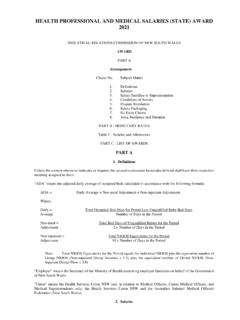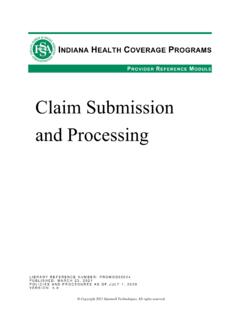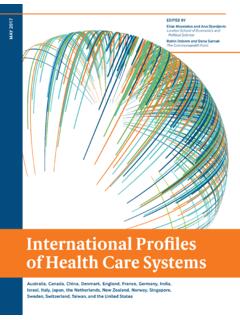Transcription of GUIDELINES - ec.europa.eu
1 Final Version GUIDELINES on the benefit-risk assessment of the presence of phthalates in certain medical devices Scientific Committee on Health, Environmental and Emerging Risks SCHEER GUIDELINES on the benefit-risk assessment of the presence of phthalates in certain medical devices covering phthalates which are carcinogenic, mutagenic, toxic to reproduction (CMR) or have endocrine-disrupting (ED) properties The SCHEER adopted this document at plenary meeting on 18 June 2019 GUIDELINES on the benefit-risk assessment of the presence of CMR/ED phthalates in certain medical devices (final version) _____ _____2 ABSTRACT The SCHEER was requested to provide GUIDELINES on the benefit-risk assessment (BRA) of the presence, in the medical devices specified in the regulation, of phthalates, which have one or more of the following properties.
2 Carcinogenic, mutagenic, toxic to reproduction (CMR) or endocrine-disrupting (ED), according to the criteria outlined in the legal obligation section from the mandate. Phthalates are widely used in industry as plasticisers of polymers, in a variety of applications such as coated fabrics and roofing membranes, as well as in medical devices, adhesives, paints, inks and enteric-coated tablets. Di-(2-(ethylhexyl) phthalate (DEHP) is the most widely used phthalate in medical devices. Dimethyl phthalate (DMP) and diethyl phthalate (DEP) are not used as plasticisers but as additives in cosmetics, medical devices, and household products.)
3 The interaction of phthalates with the polymers they are embedded in is weak, so they may be released from the plastic product into the environment and into the human body if the product is in contact with it. The Medical Device Regulation, Regulation (EU) 2017/745 allows the use of CMR 1A/1B and/or ED substances in medical devices above a concentration of w/w. when a proper justification can be provided (Annex I, Chapter II Section ). For such a justification several steps need to be considered including the availability of alternative substances, materials, designs, and medical treatments.
4 In addition, the risk associated with such alternatives should be weighed against the risk of the use of CMR 1A/1B and/or ED identified phthalates covered under MDR Annex I Chapter II Section However, the risk by itself is not the only parameter to consider: also the impact of the possible alternatives on the functionality, performance and the overall benefit-risk ratio of the medical device shall be evaluated. These GUIDELINES describe the methodology on how to perform a BRA for the justification of the presence of CMR 1A or 1B and/or ED phthalates (CMR/ED phthalates) in medical devices and/or or parts or materials used therein at percentages above by weight (w/w).
5 They also describe the evaluation of possible alternatives for these phthalates used in medical devices, including alternative materials, designs or medical treatments. They are intended to be used by the relevant stakeholders manufacturers, notified bodies and regulatory bodies. The approach of these GUIDELINES may also be used for a BRA of other CMR/ED substances present in medical devices. During the preparation of these GUIDELINES for BRA of the use of CMR/ED phthalates in medical devices, SCHEER noticed that a number of BRA methodologies are theoretically available.
6 However, there is a considerable lack of data needed for the BRA for potential relevant alternatives to be used in medical devices. Therefore, SCHEER encourages manufacturers to generate data of high quality on such alternatives for CMR/ED phthalates in medical devices. Pending on new scientific evidence, it is recommended to evaluate the use and usefulness of these GUIDELINES after an application period of three years. Keywords: GUIDELINES , benefit-risk assessment, CMR/ED phthalates, medical devices, SCHEER.
7 GUIDELINES to be cited as: SCHEER (Scientific Committee on Health, Environmental and Emerging Risks), GUIDELINES on the benefit-risk assessment of the presence of phthalates in certain medical devices covering phthalates which are carcinogenic, mutagenic, toxic to reproduction (CMR) or have endocrine-disrupting (ED) properties, final version adopted at SCHEER plenary on 18 June 2019. GUIDELINES on the benefit-risk assessment of the presence of CMR/ED phthalates in certain medical devices (final version) _____ _____3 ACKNOWLEDGMENTS Members of the Working Group are acknowledged for their valuable contribution to this opinion.
8 The members of the Working Group are: SCHEER members: Teresa Borges Rodica Mariana Ion Wim H. de Jong (Chair and Rapporteur) Demosthenes Panagiotakos Emanuela Testai Theo Vermeire SCCS members: Ulrike Bernauer Christophe Rousselle External experts: St phane B gu (Etablissement Fran ais du Sang, EFS, Paris, France) Hilde B. M. Kopperud (Nordic Institute of dental Materials, Oslo, Norway) Maria Rosaria Milana (Istituto Superiore di Sanit , Dip. Ambiente e Salute, Roma, Italy) Tanja Schmidt (Ansbach University of Applied Science, Ansbach, Germany) Experts from EU Agencies: Francesco Pignatti (European Medicines Agency) Evgenia Stoyanova (European Chemicals Agency) Katarina Volk (European Food & Safety Authority) All Declarations of Working Group members are available at the following webpage.
9 GUIDELINES on the benefit-risk assessment of the presence of CMR/ED phthalates in certain medical devices (final version) _____ _____4 About the Scientific Committees (2016-2021) Two independent non-food Scientific Committees provide the Commission with the scientific advice it needs when preparing policy and proposals relating to consumer safety, public health and the environment. The Committees also draw the Commission's attention to the new or emerging problems which may pose an actual or potential threat.
10 They are: the Scientific Committee on Consumer Safety (SCCS) and the Scientific Committee on Health, Environmental and Emerging Risks (SCHEER). The Scientific Committees review and evaluate relevant scientific data and assess potential risks. Each Committee has top independent scientists from all over the world who are committed to work in the public interest. In addition, the Commission relies upon the work of other Union bodies, such as the European Food Safety Authority (EFSA), the European Medicines Agency (EMA), the European Centre for Disease prevention and Control (ECDC) and the European Chemicals Agency (ECHA).














